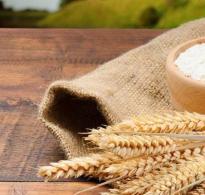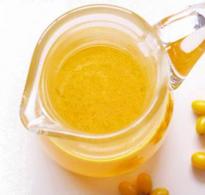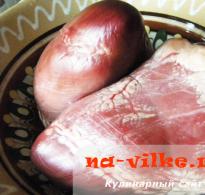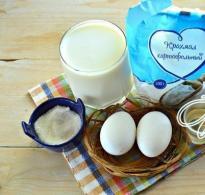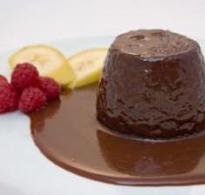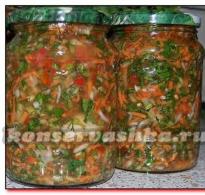Tasty, original and healthy. Learning to pickle wild garlic
Summer is the time when huge amount people are actively preparing for the winter. Among the numerous greens for pickling, you can use wild garlic, which has spicy taste, similar to garlic. In addition, this plant is very beneficial for the body, since it contains vitamins, minerals and other substances. Even after heat treatment quite a lot remains in the leaves and petioles useful components.
It is important to know not only how to salt wild garlic, but also when to harvest it correctly. The ideal time for collection is from May to June. It is important that flowers do not appear on the plant. Only fresh and beautiful leaves without any damage are suitable for preparations. They should be processed immediately after they have been picked. You can prepare first and second courses from the greens stored for the winter, and also use them for salads, snacks and baked goods.
How to pickle wild garlic with brine for the winter?
Many people don't even realize that plant stems can be harvested. There are many different ways salting, we suggest focusing on the most popular option.
For this recipe you need to take:
- leaves and stems of the plant, spices, herbs, water;
- 1 liter of liquid a glass of salt.
Preparation:
- The leaves need to be washed thoroughly and then laid out on a paper towel to dry;
- Take clean jars. Place wild garlic in them, and also add selected spices and various herbs;
- For pickling, brine is important, for which you need to combine water and salt. Pour it into jars and leave for a couple of days under loosely closed lids;
- During this time, foam will form on the surface, which should be removed. After this, add fresh brine to the jars and close the lids.
How to pickle wild garlic with currant and cherry leaves at home?
Thanks to the use of currant leaves, the snack ends up being more aromatic and piquant. It is important to take freshly picked leaves, without stains or damage.
- wild garlic stems, cherry leaves, currants, various spices, black peppercorns, dill sprigs and seeds, water and a certain amount of salt.
Preparation:
- As in the previous recipe, you need to rinse the wild garlic leaves thoroughly in running water and then dry them;
- Place the leaves of the plant, currants, cherries, as well as pieces of horseradish and other ingredients to taste in clean jars in layers;
- Prepare a brine, for which take 50 g of salt per 1 liter of water. Place a plate with pressure on the jars;
- On the surface of cans that should be left at room temperature, foam will form and must be removed. This process can take up to 2 weeks. It is also important to wash the plate with a salt solution;
- After completing the fermentation process, you need to add the missing brine to the jars and roll it up.
How to pickle wild garlic with vinegar at home?
Thanks to the use of vinegar, the pickling process is greatly simplified and accelerated. The final snack tastes piquant.
For brine you need to take the following products:
- 1 tbsp. water;
- 210 g vinegar;
- 1 tbsp. a spoonful of salt;
- 2 tbsp. spoons of sugar.
If desired, you can use different spices, for example, pepper or cinnamon.
Preparation:
- Leaves and shoots of wild garlic must first be soaked in cold water within an hour;
- Place them in jars and fill with brine, for which you combine vinegar, water, salt and sugar. Roll up the jars and leave upside down for 2 hours at room temperature.
How to pickle a product without brine?
There are several options instant cooking such a snack. Leaves salted in this way can be used to prepare salads, first and second courses.
Let's look at the 2 simplest recipes:
- The first option is similar to preparing the usual sauerkraut. To begin with, rinse the leaves and stems well, and then cut them into pieces no larger than 1 cm. Salt the pieces of the plant at the rate of 450 g of salt per 10 kg of wild garlic. This is best done in a wide basin. Put pressure on it and leave it for 5 days. It is important to remove the foam periodically. After the time has passed, you need to put the pieces into jars and close them. It should be stored in the basement or in the refrigerator.
- To pickle young stems and leaves, you need to wash everything thoroughly and mix with salt. For 1 kg of plant you will need 2 tbsp. spoons of rock salt. Immediately after this, put everything into jars and compact them well so that there are no voids. The jars are not rolled up, but simply covered with a plastic lid. Must be stored in the refrigerator. After 10 days, the snack can be eaten.
How to prepare wild garlic salad with lard for the winter?
The prepared snack can be consumed separately, for example, spread on bread, or used in salads, first courses and as a filling for baked goods. Everything is prepared quickly and simply.
For this recipe you need to take the following products::
- 400 g lard;
- 200 g wild garlic;
- 1 tbsp. a spoonful of salt and spices.
Important to use fresh lard without meat layer and skin.
It is best to cook according to step by step recipe pickling wild garlic for the winter:
- The first thing to do is grate the lard using the entire amount of salt. Then, it should be placed in an enamel bowl, covered with a lid and left for a day;
- After time, excess salt from the lard should be removed and cut into pieces. Then, it is combined with chopped herbs and minced in a meat grinder;
- The resulting mass should be mixed thoroughly and spices should be added if desired. It needs to be divided into jars and closed with lids. Store in the refrigerator, but no more than a year.
Horseradish pickling recipe
Another option savory snack, which is in winter period will not only help you warm up, but also fill you up useful substances organism. You can eat this dish immediately after cooking, but it becomes tastier after a few months.
For cooking you need to take the following products:
- 3 parts wild garlic, part horseradish and dill root, bay leaf, peppercorns;
- For 1 liter of water you need to take 2.5 teaspoons of salt.
Preparation:
- To make a salad, you first need to prepare the leaves of the plant. They should be washed and then dried;
- Place leaves in jars, alternating with laurel, horseradish and dill. Pour in the prepared brine. Place a wooden circle in the neck and apply pressure;
- After some time, the fermentation process will start, so you need to periodically remove the foam and wash the oppression in salt;
- After 2 weeks, the oppression can be removed. Add the missing brine and close the jars. Store in a cool, dark place.
How to add salt in tomato sauce?
Another unusual recipe that allows you to get very delicious salad, which can be enjoyed at any time of the year. Everything is easy to prepare and you need readily available ingredients.
Pickling wild garlic- This is one of the most popular and simple ways prepare this unique wild plant for the winter. The taste of this preparation resembles the taste of garlic, so it can be safely served with a dish of meat, fish, etc.
Recipe for pickling wild garlic.
Ingredients:
- salt
- leaves of freshly cut wild garlic with long petioles
Preparation:
1. Rinse the wild garlic leaves thoroughly, dry them using a paper towel, and carefully place them in a glass container that has a wide neck.
2. Be sure to add salt to each layer of wild garlic.
3. Place a wooden circle or plate on top of the wild garlic, and then a bend.
Ready wild garlic is stored well in the refrigerator.

Pickling wild garlic for the winter recipe No. 2.
Ingredients:
- wild garlic leaves
- water – one liter
- salt – 55 g
Preparation:
1. Wash the plants thoroughly, dry them, place them in glass jars or barrels, layering them with spices - allspice, bay leaf, horseradish roots, dill, etc.
2. Fill jars or barrels with saline solution, place a wooden circle and a small pressure on top.
3. In the first days, foam will appear on the surface - it must be removed. In this case, the bend and the circle must be washed with fresh saline solution.
4. After two weeks, fermentation will end. Add brine to the container, close it, and place it in cool place.

. Canned wild garlic.
Ingredients:
- young wild garlic feathers
- water – one liter
- salt, vinegar - 20 g each
Preparation:
1. Peel the wild garlic feathers from the first leaves, rinse, blanch for a minute in boiling water, cool under running water, let the water drain.
2. Prepare a 2% saline solution (dissolve 20 g of salt in a liter of water), boil it, filter through a thick cloth, add 20 g table vinegar.
3. Place the prepared wild garlic in jars, fill with brine two centimeters below the edge of the jar, cover with lids, and sterilize.
If you don't like salting foods, try pickling.
Pickled wild garlic is no less tasty than salted wild garlic.
Pickled wild garlic.
Ingredients:
- sugar, salt – 50 g each
- vinegar – 120 g
- water – one liter
- fresh leaves wild garlic
Preparation:
1. Wash the wild garlic leaves, cut into pieces, blanch for two minutes, then cool under cold water.
2. Place wild garlic leaves tightly into preheated jars and fill with boiling liquid.
3. The filling is prepared as follows: dissolve salt and sugar in water, boil for a couple of minutes. As soon as the filling has cooled a little, add table vinegar, stir, pour into jars with wild garlic leaves, not reaching 1.5 cm from the edge of the jar.
4. Cover the jars with lids, sterilize for 5 minutes, and seal.
Fresh wild garlic can also be used to make
Ramson is a plant of the Onion family. It has healing and pleasant nutritional characteristics. Grows in Europe, the Caucasus and Turkey. Young leaves are used for food. They are moderately spicy, but not bitter. Wild garlic is added to various snacks and salads, and can also be preserved for the winter at home. The most popular preparation is pickled wild garlic. For those who like it a little spicier, you should try this Korean snack recipe.
Ramson in Korean
Recipe for gourmets and lovers of spicy food.
Advice. Persons with gastrointestinal diseases should not eat spicy foods.
In order to cook wild garlic in Korean, you will need several bunches of it, one carrot, Korean seasoning, 1 tsp. sugar and 0.5 tsp. salt, as well as 4 tbsp. l. vegetable oil and 2 tbsp. l. wine vinegar.
As a rule, all recipes for cooking wild garlic begin with washing and scalding with boiling water. Only after this can you begin the main canning process.
- The boiling water needs to be drained and the wild garlic placed in a deep container.
- Finely chop the carrots into long strips and place with the wild garlic. You can use a special grater.
- The next step is preparation spicy sauce. Vinegar, Korean seasoning, sugar and salt should be mixed and poured into the salad.
- Fill it with oil and mix well.
- Place the Korean wild garlic into jars and leave for a couple of hours. After this, the salad is ready to eat.
- If you want to prepare salad for the winter, you must first sterilize it in a jar and roll it up with a lid.
Pickled wild garlic
Marinating – great option how you can preserve useful and tasty qualities wild garlic for the winter. For this you will need 0.5 kg of wild garlic, 1.5 liters of water, 100 g of cranberries, 150 g of table vinegar (9%), 3 tbsp. l. granulated sugar and 1.5 tbsp. l. salt.
- Rinse the wild garlic and place it in pre-sterilized jars.
Advice. The wild garlic needs to be soaked in water for several hours before cooking. This is done in order to get rid of bitterness.
- Place cranberries on top.
- Then prepare the brine. You just need to add salt and sugar to boiling water. Wait until they dissolve and pour in the vinegar.
- Pour the prepared marinade over the wild garlic and seal the jars.
Salted wild garlic
The recipe for making salted wild garlic is incredibly simple. You will need 1 kg of wild garlic and 2 tbsp. l. coarse salt.
- The wild garlic needs to be washed and dried.
- Then it should be chopped, but not very finely.
- Add salt and mash well.
- Pack into sterilized jars and seal with a lid.
Attention! Salted wild garlic should be stored cool. For example, in the refrigerator, basement or cellar.
Salted wild garlic retains its beneficial properties. It can be used in in the usual form, salads or add to first courses.
Wild garlic in tomato sauce
To prepare wild garlic with tomato sauce as a preparation for the winter, you will need to take 2 kg of plant leaves, 0.2 kg of any tomato paste, 4 tbsp. l. salt, 2 tbsp. l. granulated sugar, 2-3 bay leaves, 5-6 black peppercorns and 0.8 liters of water. The preparation procedure is very simple:
- Wash the plant, scald with boiling water and place the wild garlic in glass jars.
- Bring the water to a boil.
- Add all the remaining ingredients to the water and boil a little.
- Pour the brine into jars with wild garlic and sterilize for a quarter of an hour.
- Tighten the jars, turn them upside down and cover with a warm blanket.
Lard with wild garlic
Unusual and hearty recipe using wild garlic. He rarely survives until winter. As a rule, it is eaten immediately after preparation. You will need 0.2 kg of lard, 0.1 kg of wild garlic, as well as salt, pepper and spices (to taste).
- Grind lard and wild garlic in a meat grinder. You can do this one by one.
- Add salt, pepper, spices and mix well.
- Place the finished mixture in a jar and put it in the refrigerator.
- The appetizing snack is ready. It is spread on bread and used as a sandwich.
The benefits and harms of the plant
The second name for wild garlic is “bear’s ear.” Many people are concerned about the benefits and harms of using this herbs. The main properties of wild garlic are bactericidal and fungicidal effects. In addition, it has a positive effect on many body processes.
- Improves the functioning of the gastrointestinal tract.
- Helps get rid of worms.
- Boosts immunity.
- Positively affects men's health.
But you will have to stop eating wild garlic if you have peptic ulcer stomach, gastritis with increased level acidity, cholecystitis or pancreatitis.
Attention! Consume wild garlic in moderation. Excessive intake of the plant in food leads to swelling, stomach upset, migraines and insomnia.
Harvesting wild garlic for the winter - simplest option preserving the plant for the winter. It takes very little time to prepare. But the dishes turn out healthy and tasty. Pickled and salted wild garlic are the most popular recipes. This Korean dish will be appreciated by lovers of spicy food. Unusual recipe lard with wild garlic will surprise any gourmet, and the spice in tomato sauce Suitable for adding to soups and main courses. The plant has useful qualities, but should be consumed in moderation.
Pickled wild garlic: video
Wild garlic preparations: photo









In early spring, wild garlic appears on store shelves. This herbaceous plant resembles young garlic. Thanks to his amazing taste and a host of useful properties, it is winning more and more fans every year. But it is impossible to stock up on fresh wild garlic for the whole year, so many housewives prepare it for future use.
Methods for pickling wild garlic
Method No. 1

Compound:
- Leaves and shoots of fresh wild garlic
Preparation:
- Wash the leaves and shoots of wild garlic, dry them (you can use a napkin or towel), then cut them into pieces 5 cm long.
- After this, place carefully in a container with a wide neck. Sprinkle each resulting layer thoroughly with salt. Place a weight on top.
- After 2 weeks, remove the wild garlic and place it in jars. Cover them with lids and put them in the refrigerator.
Method number 2

Compound:
- Water - 1 l
- Salt - 70 g
- Wild garlic leaves
- Bay leaf, black peppercorns, fresh dill or horseradish to taste
Preparation:
- First, prepare the brine by adding 70 g of salt to 1 liter of water. Its volume depends on the amount of wild garlic you want to pickle. It is advisable to salt the leaves of the grass, since they are more delicate, but the stems are also suitable for the winter.
- Before salting, rinse the prepared leaves very thoroughly under running water, preferably cold, and dry by laying them on a flat surface on a towel.
- While the raw materials for pickling are drying, prepare bay leaves, horseradish or fresh dill, and black peppercorns. These ingredients will give the product a special aroma. Also, make sure that the canning jars are sterilized in a water bath in advance.
- Place wild garlic leaves in layers, alternating layers of spices, bay leaf and dill. If you want, you can add garlic cloves to taste for spiciness. After this, fill the workpiece with brine and close the lids loosely.
- Leave the jars for several days, during which time remove any foam that forms from the surface. If necessary, add brine.
- After 14 days, the fermentation process should end, now fill the jars with prepared fresh pickling solution and roll up.
- Place in a cool place.
Method number 3

Compound:
- Wild garlic leaves
Preparation:
- Wash the leaves well, dry, chop finely and place in a wide saucepan. Sprinkle each resulting layer with salt. Mix everything, place a dish on top to cover the surface and pressure.
- After the wild garlic gives juice, place it in glass jars and compact it. Leave for 24 hours. As soon as the mass settles, add it to other jars. For better storage Sprinkle a layer of salt on top of the greens.
- Place the finished wild garlic in the refrigerator.
Harvesting wild garlic for the winter can be done not only by salting, but also by using more simple recipe, where the main ingredient is vinegar. To prepare the brine for wild garlic, you will need:

Compound:
- Vinegar - 200 g
- Sugar - 2 tbsp. l.
- Salt - 1 tbsp. l.
- Water - 200 ml
- Bay leaf, cinnamon or cloves, black peppercorns - optional.
Preparation:
- Prepare wild garlic leaves or stems, sort them and wash them.
- Place greens in cold water to soak. Pour boiling water over the jars. After an hour, place the leaves in jars and pour hot brine on top. Then carefully close the lids.
- Leave for 2 days to settle and put in a dark and cool place. It is best to turn the jars over before doing this.
Hi all!
Yesterday we went to collect wild garlic or bear onions.
Surprisingly useful, rare, but extremely popular in folk medicine.
From this article you will learn:
Wild garlic for the winter - preparation recipes
What is wild garlic?
Ramson, or Bear's Onion, or Wild Garlic, or Kalba (lat. Allium ursinum) perennial herbaceous plant, species of the genus Onion ( Allium) subfamily Onion ( Alliaceae) family Amaryllidaceae ( Amaryllidaceae) wiki

Useful properties of wild garlic
ABOUT beneficial properties you can talk for a long time about wild garlic.
The plant is extremely rich in a variety of vitamins and minerals.
Her emerald leaves contain a storehouse of healthy ingredients, and their spicy, hot-sweet garlic flavor can complement any dish.
In terms of its medicinal effects, wild garlic is similar to garlic.
Methods of treatment with wild garlic were known back in Ancient Rome, where wild garlic was considered a means of cleansing the stomach and blood.
In folk medicine, wild garlic is used as an antiscorbutic, anthelmintic, a means of enhancing intestinal motility, and as a blood purifier for diseases of atherosclerosis.
And of course, wild garlic has a pronounced antimicrobial effect. Moreover, its phytoncides are even stronger in action than the phytoncides of garlic (they can even prevent rotting of meat)
Therefore, wild garlic can be successfully taken for various infectious intestinal diseases, skin rashes, colds, and periodontal disease.
Tincture of wild garlic with alcohol effectively helps with rheumatism and gout.
Vitamins included in wild garlic large quantities, give it a rejuvenating effect on our body.
Therefore, if you have the opportunity to collect or buy wild garlic, do not miss it.
Recipes for preparing wild garlic for the winter
Wild garlic can be prepared for the winter: salted, fermented, and then added to soups, salads, fillings for pies, and as a seasoning for any dishes.
Let's look at the basic recipes for preparing wild garlic for the winter.

The simplest recipe for preserving wild garlic for the winter looks like this:
For 2 kg of wild garlic leaves, take 1.5 liters of water, 40 g of salt and 1 tbsp. l. 6% vinegar.
- Before cooking, the leaves should be thoroughly washed, then the wild garlic should be cut or the leaves should be left whole (depending on preference).
- Boil water, salt it, add herbs and leave to boil for a couple of minutes.
- Transfer the leaves into jars, fill them with the water in which they were boiled, after adding vinegar to it and boiling for a couple of minutes.
- The jars must be closed immediately and left at room temperature to cool.
Video recipes for preparing wild garlic for the winter
From these videos you will learn how to cook delicious and healthy snack from wild garlic for the winter. Look!!!
Salted wild garlic
Cooking recipe:
- Take about 1 kg of wild garlic leaves and stems, rinse with boiling water.
- Finely chop.
- Place in glass jars or a birch bark barrel.
- First add a layer of salt, then a layer of wild garlic, and so on until the container is filled to the brim.
- You can also use sea salt. Very tasty!
- You can also ferment wild garlic, read
Sauce with wild garlic

A simple spicy sauce with wild garlic. Spicy, but very tasty with meat and fish.
Rinse the wild garlic thoroughly in cold water and pass through a meat grinder. Add salt to taste. Place in sterile jars and store in the refrigerator.
I really like simple potato salad with wild garlic.
To prepare it, 5 baked potatoes, cut into cubes, mixed with a bunch of chopped wild garlic, and seasoned with salt and vegetable oil.
You can add chopped egg. Very tasty and very healthy!

And finally, in order not to drive through the fields in search of bear onions, plant wild garlic in your dacha.

It easily propagates by bulbs or seeds, and in the worst place, where it’s dark and damp, wild garlic loves it!
And you will always have healing greens that bring health!
Do you like wild garlic?
Alena Yasneva was with you, subscribe to my blog updates and goodbye to everyone!!!


